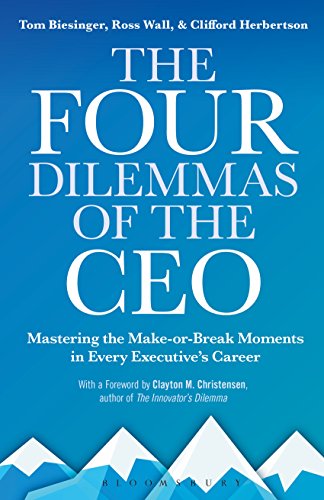The Four Dilemmas of the CEO
Mastering the Make-or-Break Moments in Every Executive's Career


The three authors are experienced consultants advising senior executives, CEOs and Boards on strategy, human capital and operational performance. They have recently launched a new business, Teallach Partners, based in the UK
The author's hypothesis is that "momentum is [every CEO's] most prized possession" and if they lose it or fail to attain it, they will achieve little to nothing. In the struggle to enable momentum CEO's will be on a CEO life-cycle' journey, and at each stage will encounter disruptive dilemmas. The challenge is how much time they should spend fire-fighting these issues, and how much they should remain above the fray guiding and growing the business.
CEO's have the option of being 'in' the business, fire-fighting and getting involved in detail and implantation issues at all levels; or being 'on' the business, defining the strategy and creating the connections and opportunities for the business to move ahead with. Those CEOs that spend more time 'in' than 'on' the business will fail to establish the required momentum for growth. The author's see a CEO's tenure as having four distinct phases; at each phase he or she will face a different key dilemma, and the split between being 'in' or 'on' the business will shift. Initially there is a need to be predominantly 'hands-on' . As a new CEO, particularly if you are an outsider, you may be in charge of everything, but understand little under the surface. You arrive with conviction, but lack relevance. You need to clear out the noise and set your own Agenda formally and informally. The informal agenda is the political one, who will do what. This is an old school "command and control" leadership moment. As the Agenda beds in Dilemma Two arises. The loyal earl supporters, may turn out not to be the best operators. You will face a choice between loyalty and competence. It is a common error to believe you can achieve both early on in a CEO tenure. In order to achieve 'momentum' you will need loyalty before competence, as you cannot risk 'resistance' from the competent. The authors offer a set of rules, their Organizational Quotient, 0Q, to help manage this process, and build a competent team, that are framed around results, reputation, alignment and power.
With the team in place and the Agenda being delivered, the temptation is to rest a little and "shift from offence to defence". Dilemmas three and four then appear. Dilemma three is moving your executive team from being 'in' the business to 'on' the business, getting them to survey the wider horizons and see where the threats and opportunities lie externally. The fourth is to clarify if you have the conviction to start-over with the organization, or would rather get more energy moving on yourself.
The book is engagingly written, though a certain uber-confidence emanates from the authors, with plenty of reference to "our wisdom" and "accomplish more than you ever thought possible". What this confidence provides though is a very clear set of directions on how to act and what to do. It offers a leadership route that is very certain for managing in uncertain times. Great leadership in today's fast-moving world requires an ever-changing balance of nuance and clarity. The approach of this book is certainly clear, and the authors' experience with CEOs underlines what a testing role it can be.
Title: The Four Dilemmas of the CEO: Mastering the Make-or-Break Mements in Every Executive's Career
Author/s Name/s: Tom Biesinger, Ross Wall and Clifford Herbertson
Publisher: Bloomsbury (Business and Management)
ISBN: 978-1-4729-4684-3
Publishing Date: July 2017
Number of Pages: 170
Author Knowledge Rating: 1-5 (based on their years of experience, academic expertise in subject areas, and exposure to cross-functional thinking in the area)













































Readability: 1-5 score(1=dense and v academic; 5=frantic; page turner)



































































Appropriate Length: (1=could have been written in 25% of the length;5=could have been longer)



































































Core Idea Value: (1=nonsense (or entirely esoteric); 5=game-changer)


























































